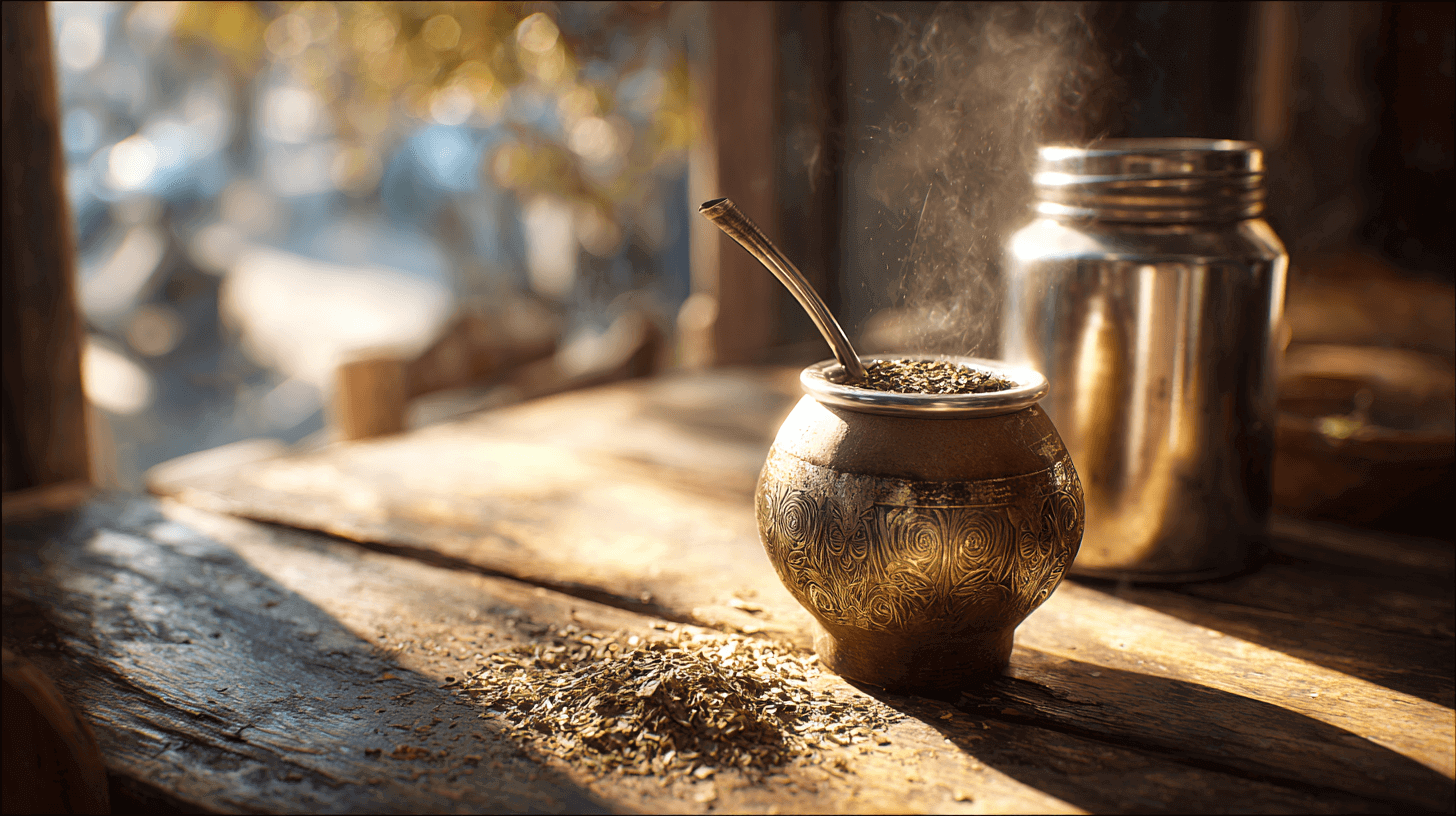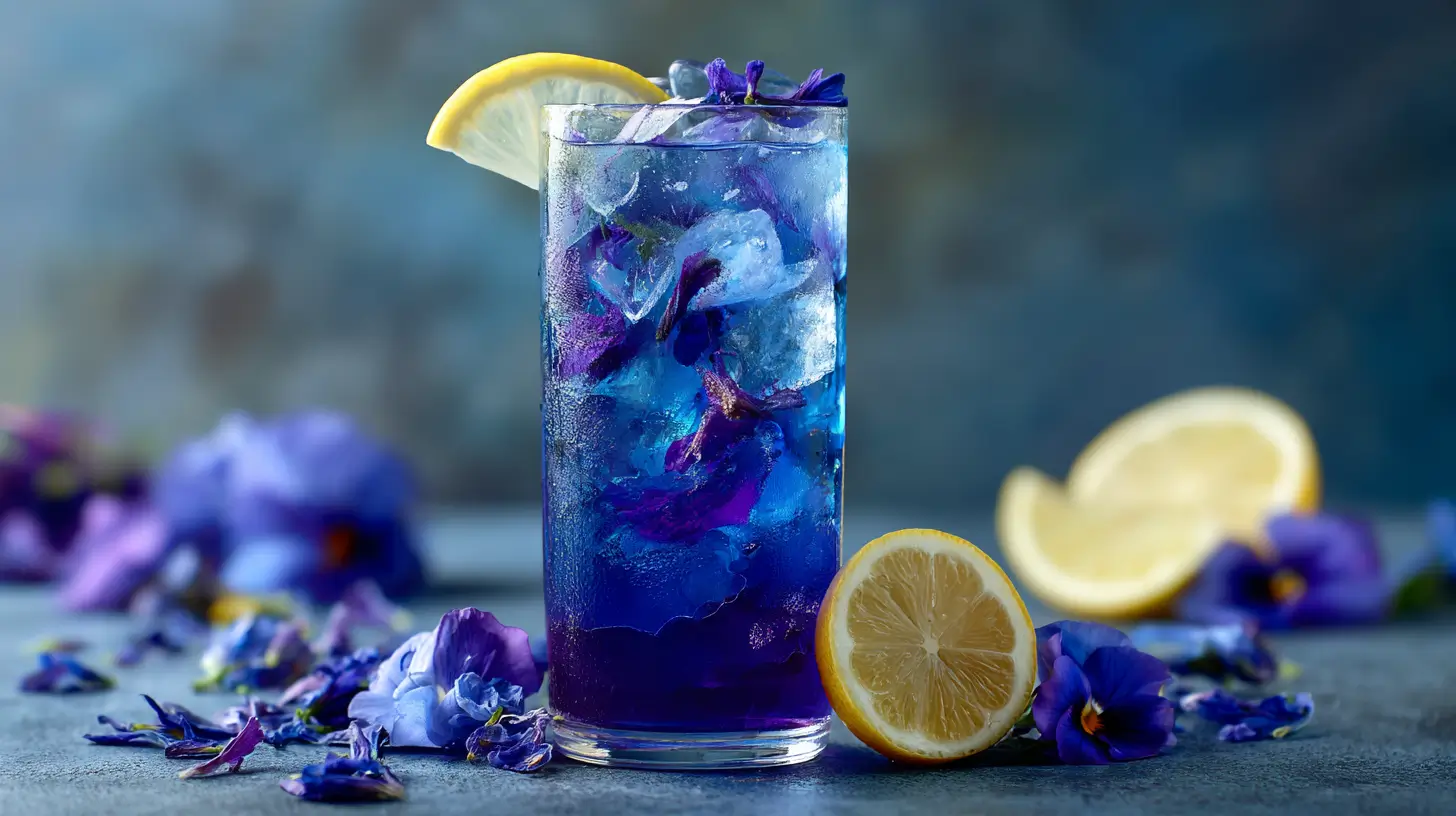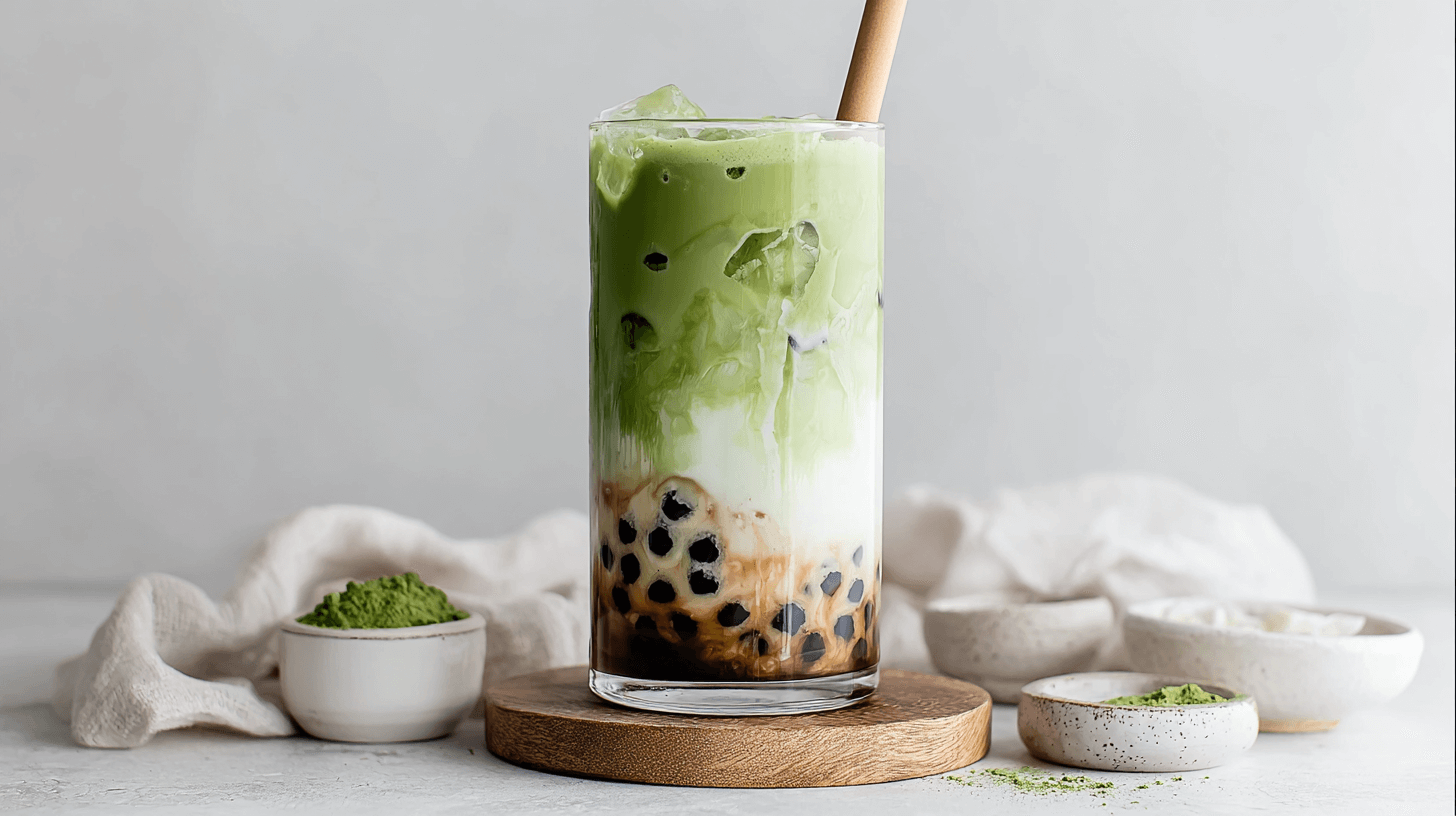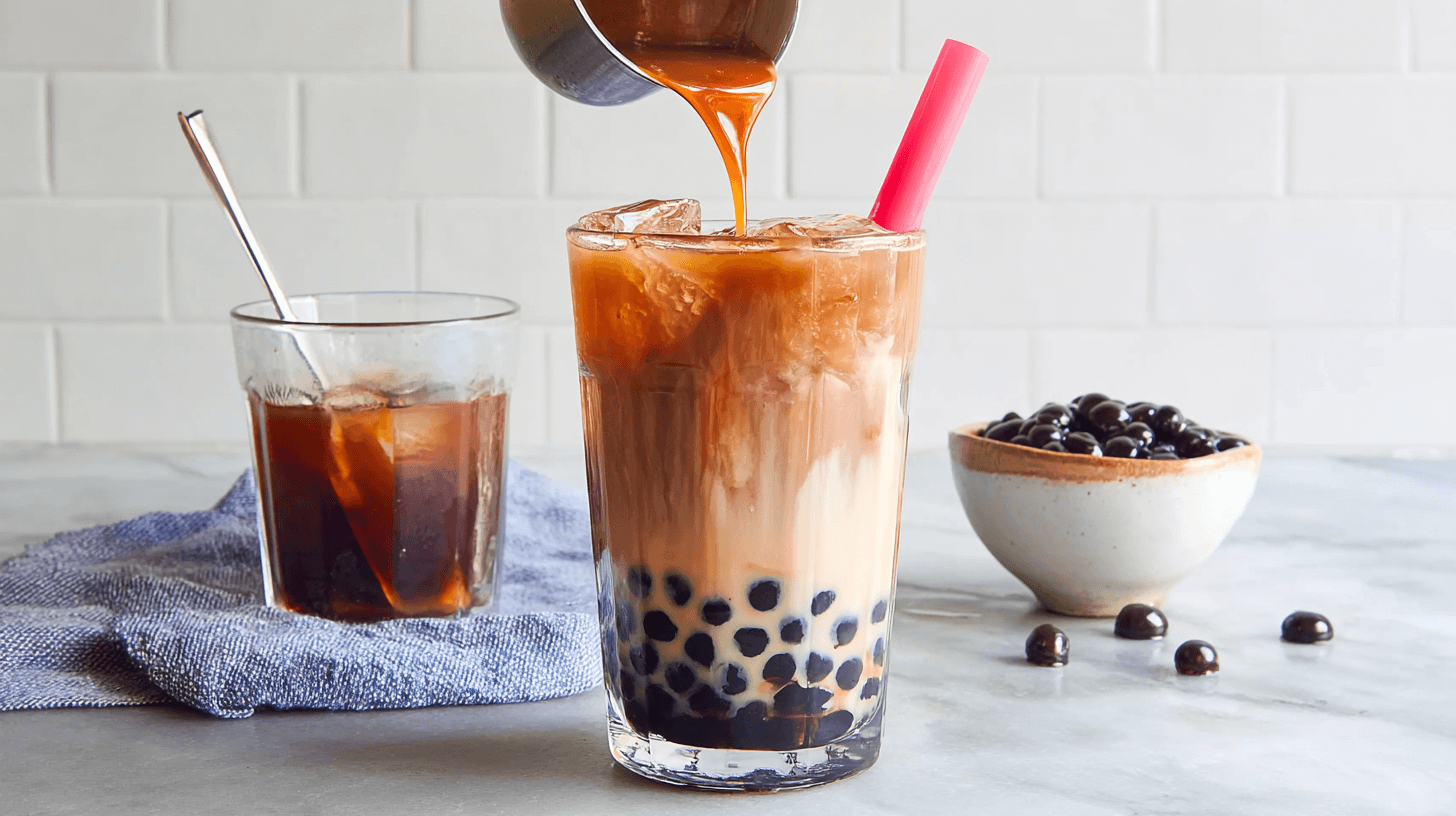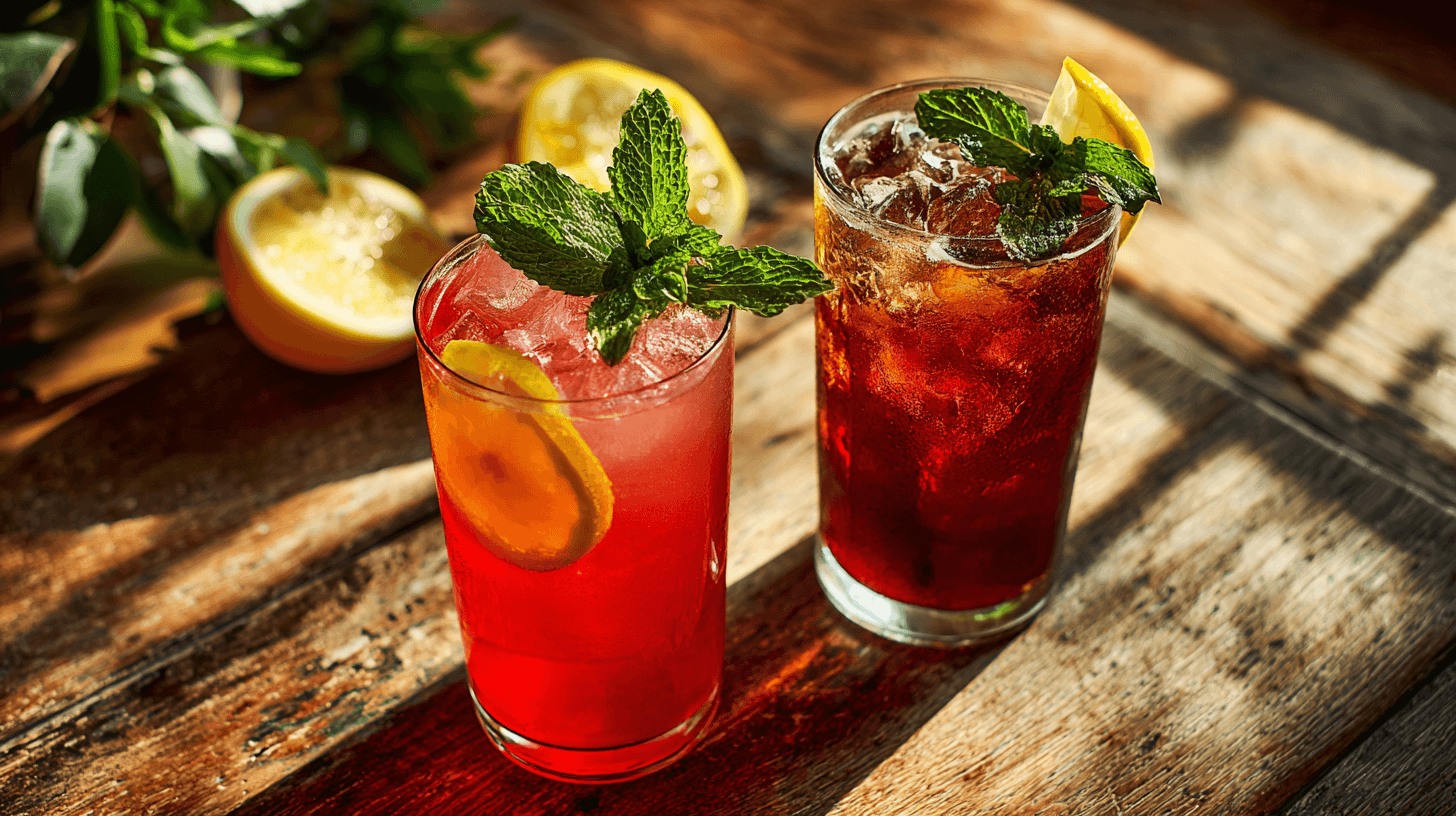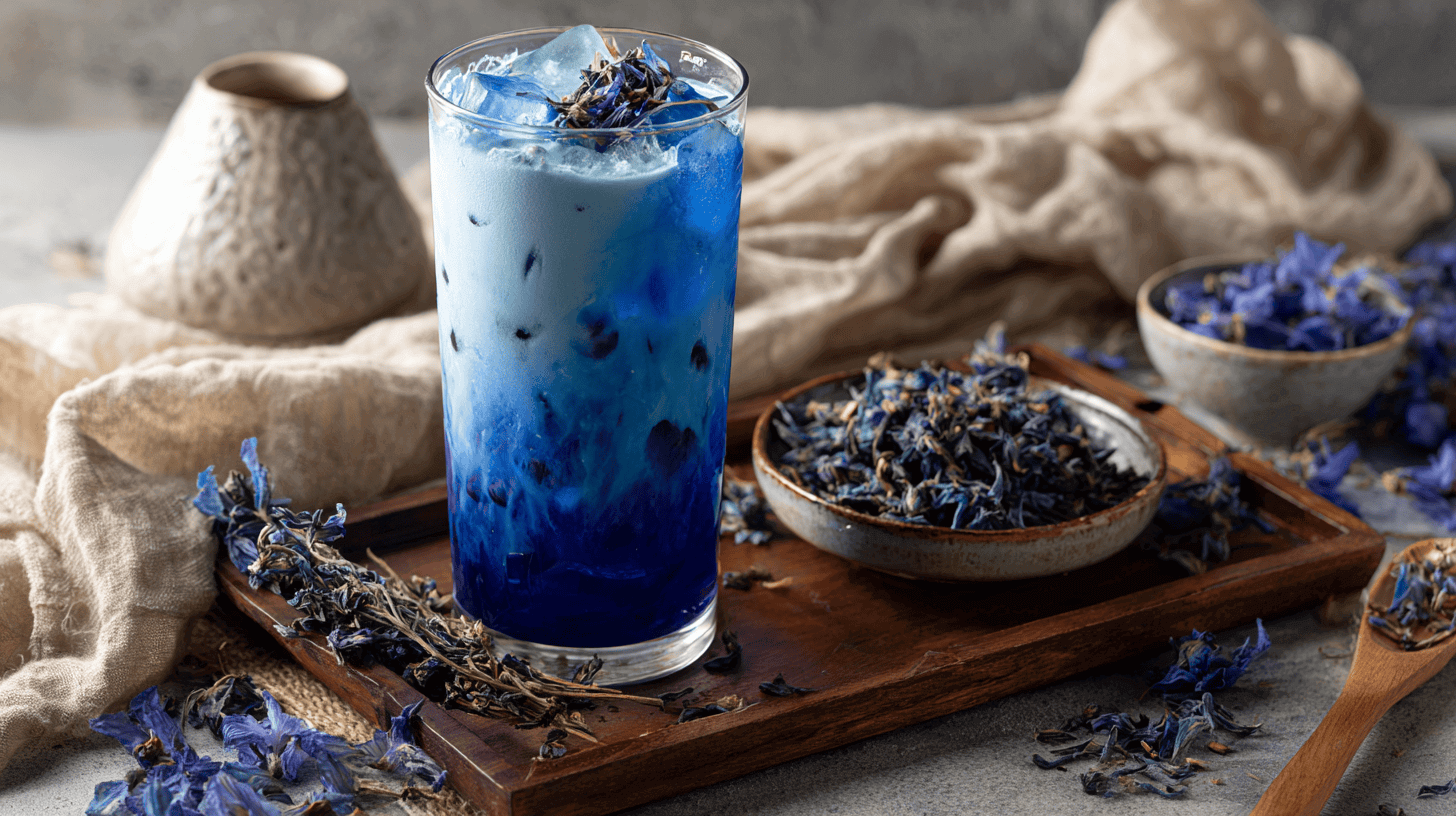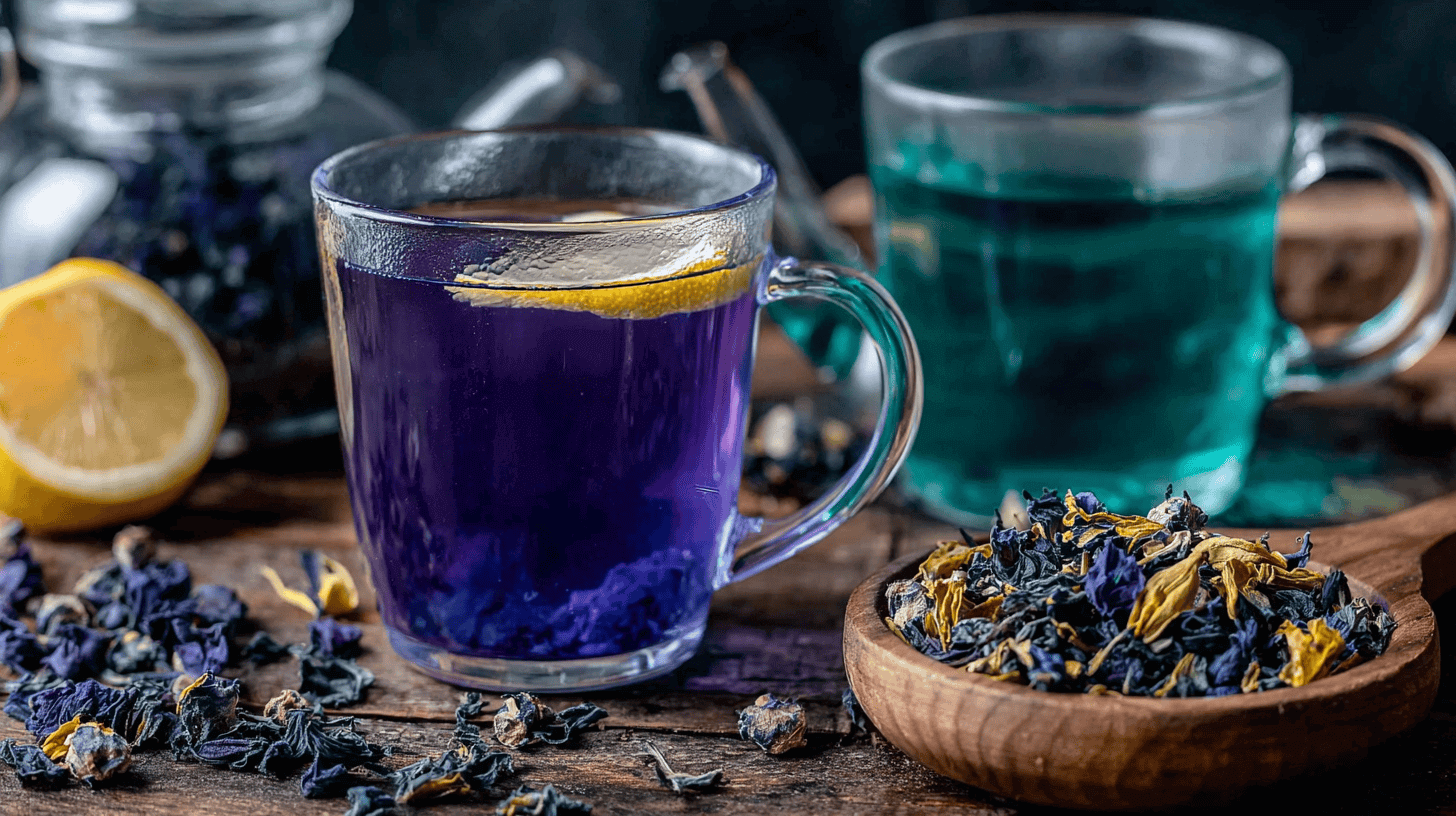Yerba mate isn’t just a drink it’s a ritual, a lifestyle, and for many, a daily companion. From the bustling streets of Buenos Aires to quiet kitchens in Ohio, this energizing brew has crossed continents and cultures. But what exactly is yerba mate, and why has it earned such global devotion? In this guide, you’ll get an honest look at yerba mate’s benefits, risks, and how to brew it like a connoisseur. Whether you’re curious about its caffeine content, traditional roots, or keto-friendly adaptations, you’re in the right place.
As someone who began their wellness journey in a small Ohio kitchen, I’ve come to love how this powerful brew offers more than energy it’s a grounding ritual that blends centuries of tradition with modern wellness.
Table of Contents
What Is Yerba Mate?
Ancient Roots, Modern Sips
Yerba mate comes from the dried leaves of the Ilex paraguariensis plant, a species native to the subtropical regions of South America. Revered by the indigenous Guarani people for centuries, it was more than a stimulant it was a spiritual beverage believed to connect them to nature and heal the body. When Jesuit missionaries arrived, they adopted the infusion for its invigorating effects, dubbing it “Jesuit tea.” Today, that same plant bridges continents and traditions. It is shared in ceremonial gourds in Argentina, served ice-cold as tereré the national drink of Paraguay, perfect for their tropical heat or whipped into wellness lattes at health cafés in Los Angeles. This remarkable adaptability is a core part of its enduring charm.
If you’re into botanical teas or curious about earthy, antioxidant-rich beverages, you might also love this Butterfly Pea Flower Tea or its iced version right here.
The Core Ingredients and Cultural Ritual
Yerba mate isn’t consumed mindlessly. Traditionally, it’s steeped in a hollowed gourd and sipped through a metal straw called a bombilla. The drink is shared communally in a circle, with the designated server, known as the cebador, refilling and passing the gourd from person to person.
Culturally, this act signifies trust, hospitality, and presence. Drinking mate isn’t just about getting your caffeine fix it’s about slowing down and truly connecting. The ritual is so ingrained that social etiquette plays a key role; for instance, one only says “gracias” (thank you) when they’ve had enough and do not wish for another refill. That’s why even modern wellness seekers embrace it. Its ceremonial nature offers calm in the middle of chaos.
Curious about caffeine alternatives with ceremonial roots? Try the floral notes of Apple Peel Tea.
The Science of Yerba Mate: A Balanced Look at Health Benefits & Risks
Potential Health Benefits (What the Research Shows)
Yerba mate’s popularity isn’t just cultural it’s backed by science. This plant contains a unique trio of stimulating xanthines: caffeine, theobromine, and theophylline. At about 80 mg of caffeine per cup, it’s comparable to coffee but often delivers a smoother, longer-lasting energy. These compounds work synergistically to promote sustained mental focus, boost energy, and enhance mood by modulating neurotransmitters like dopamine and serotonin [Source].
It’s also packed with powerful antioxidants; in fact, some analyses show yerba mate contains more polyphenols than green tea. These include caffeoyl derivatives and chlorogenic acid, which help protect the body’s cells from oxidative stress a known contributor to aging and chronic diseases such as cancer and cardiovascular disorders [Source].
Scientific research suggests yerba mate may also support weight management. It has been shown to suppress appetite, enhance thermogenesis, and increase fat oxidation. In one study, overweight participants who consumed yerba mate experienced reduced fat cell formation and improved lipid metabolism [Source]. While one cup won’t trigger dramatic weight loss, regular consumption can contribute meaningfully to a balanced wellness plan.
There’s promising evidence linking yerba mate to improved heart health. Its saponin content and anti-inflammatory effects may help reduce “bad” LDL cholesterol and triglycerides. In a 40-day clinical study, individuals who drank 11 oz (330 mL) of yerba mate daily saw an 8.5% reduction in LDL cholesterol [source]. Though it’s no replacement for medical treatment, yerba mate can be a smart addition to a heart-conscious lifestyle.
For more metabolism-friendly sips, check out this Detox Island Green Smoothie and the refreshing Chia Seed Water both nutrient-packed, naturally energizing drinks.
Understanding the Risks (A Transparent Guide)
Let’s be real yerba mate isn’t for everyone. Transparency matters, especially when it comes to health.
The most talked-about risk? Cancer. Some studies link heavy, long-term consumption of very hot yerba mate especially over 149°F (65°C) with increased risk of esophageal, lung, and bladder cancers. But here’s the nuance: it’s not just the mate it’s also the temperature. The World Health Organization’s International Agency for Research on Cancer (IARC) classifies any beverage consumed above 149°F as a “Group 2A: probably carcinogenic to humans” due to thermal injury, not because of the drink’s chemical composition .
Then there are Polycyclic Aromatic Hydrocarbons (PAHs) compounds found in smoked yerba mate, similar to those in grilled meat or tobacco. These are known carcinogens. Choosing unsmoked (air-dried) mate dramatically reduces this risk. Look for packaging labeled “sin humo.” For example, brands like Playadito and Cruz de Malta are typically air-dried and are excellent unsmoked options.
Caffeine sensitivity is another concern. A typical cup of yerba mate contains about 70–85 mg of caffeine less than coffee, but more than tea. Common side effects include jitters, insomnia, digestive discomfort, and anxiety, especially when consumed in high quantities or on an empty stomach [source].
Who should be cautious?
If you fall into any of the following categories, it’s wise to talk to your healthcare provider before adding yerba mate to your routine:
- Pregnant or breastfeeding women
- Children under 12
- People with anxiety disorders or sleep disturbances
- Individuals with high blood pressure or heart conditions
- Anyone taking monoamine oxidase inhibitors (MAOIs) or stimulant medications
While yerba mate can be part of a healthy lifestyle, it’s important to make informed, personalized choices based on your health needs.
A Connoisseur’s Guide: The 4 Main Types of Yerba Mate
Argentinian Yerba Mate
Argentina produces the most widely consumed yerba mate style in the world. It typically comes in a balanced cut known as con palo a mix of leaves, stems, and low dust. The flavor profile is mild and herbaceous, making it ideal for beginners. Most Argentine mates are air-dried, offering a clean and smooth taste. Popular beginner-friendly brands include Cruz de Malta, Playadito, and CBSe Miel.
Paraguayan Yerba Mate
Paraguayan yerba mate is known for its complex and bold flavor, thanks to a finer cut with more dust and a higher likelihood of being smoke-dried. It carries deeper notes of tobacco and dried fruit, and is the preferred style for cold-brewed tereré, especially during the country’s intensely hot summers. Brands like Pajarito and Selecta are commonly used.
Uruguayan Yerba Mate
Uruguayan mate is strong, rich, and not for the faint of palate. It has a very fine cut with almost no stems (sin palo) and high dust content. The flavor can include hints of dark chocolate, toasted grains, and peanut butter. Because of its density, it requires precise technique and a good bombilla to avoid clogging. Top brands include Canarias and La Selva, both prized for their intense character.
Brazilian Erva Mate (Chimarrão)
In Brazil’s southern states, people drink chimarrão a form of yerba mate that’s very different in both look and preparation. It’s a bright green powder, almost like matcha, made from fresh, minimally oxidized leaves. The flavor is grassy, sweet, and smooth, but the preparation is finicky. It requires a deep gourd and specific pouring techniques. Chimarrão also has a short shelf life and must be used quickly after packaging. Popular brands include Barão de Cotegipe and Ximango.
Yerba Mate Types at a Glance
| Type | Cut | Flavor | Best For | Recommended Brands |
|---|---|---|---|---|
| Argentinian | Coarse, con palo (with stems) | Herbaceous, smooth, approachable | Beginners, traditional gourd prep | Cruz de Malta, Playadito, CBSe |
| Paraguayan | Fine cut, high dust | Smoky, dried fruit, complex | Cold brews (tereré), hot summers | Pajarito, Selecta |
| Uruguayan | Ultra-fine, sin palo (no stems) | Malty, bitter, earthy | Experienced drinkers, strong flavor lovers | Canarias, La Selva |
| Brazilian (Chimarrão) | Powdered, fresh green | Grassy, mildly sweet, fresh | Daily sippers, southern Brazil tradition | Barão de Cotegipe, Ximango |
Your First Sip: A Complete Beginner’s Guide
Choosing Your First Yerba Mate
If you’re new to yerba mate, starting with a mild, Argentinian con palo blend is the easiest path to success. These versions have a balanced mix of leaves and stems with low dust, making them smoother and more forgiving for beginners. Trusted brands like Playadito and Cruz de Malta are great entry points. If you’re sensitive to bitterness, flavored blends like CBSe Honey, CBSe Pomelo, or CBSe Vanilla offer a gentle introduction without sacrificing tradition.
Essential Equipment for Brewing Yerba Mate
You don’t need much to begin just the right vessel and a straw designed for filtration. Here’s a quick breakdown of the most common types:
| Equipment | Material | Pros | Best For |
|---|---|---|---|
| Traditional Gourd (Calabash) | Natural dried squash | Cultural authenticity; rich aroma over time | Experienced or ceremonial users |
| Silicone Gourd | Food-safe silicone | Dishwasher-safe, modern, doesn’t retain odor | Beginners, daily casual drinkers |
| Glass Gourd | Tempered glass | Visually clean, non-reactive, heat resistant | Those preferring easy cleaning and visibility |
| Bombilla (Spoon-tip) | Stainless steel | Best for coarser cuts, easy to clean | Argentinian-style yerba, daily use |
| Bombilla (Spring/Coil-tip) | Stainless steel | Best for fine or dusty cuts | Uruguayan, Paraguayan yerba |
Want to try French press yerba mate? Just add 2–3 tablespoons of loose mate to your press, pour in hot (not boiling) water, let steep for 5–7 minutes, then press and pour. It’s an easy, mess-free way to enjoy yerba mate daily.
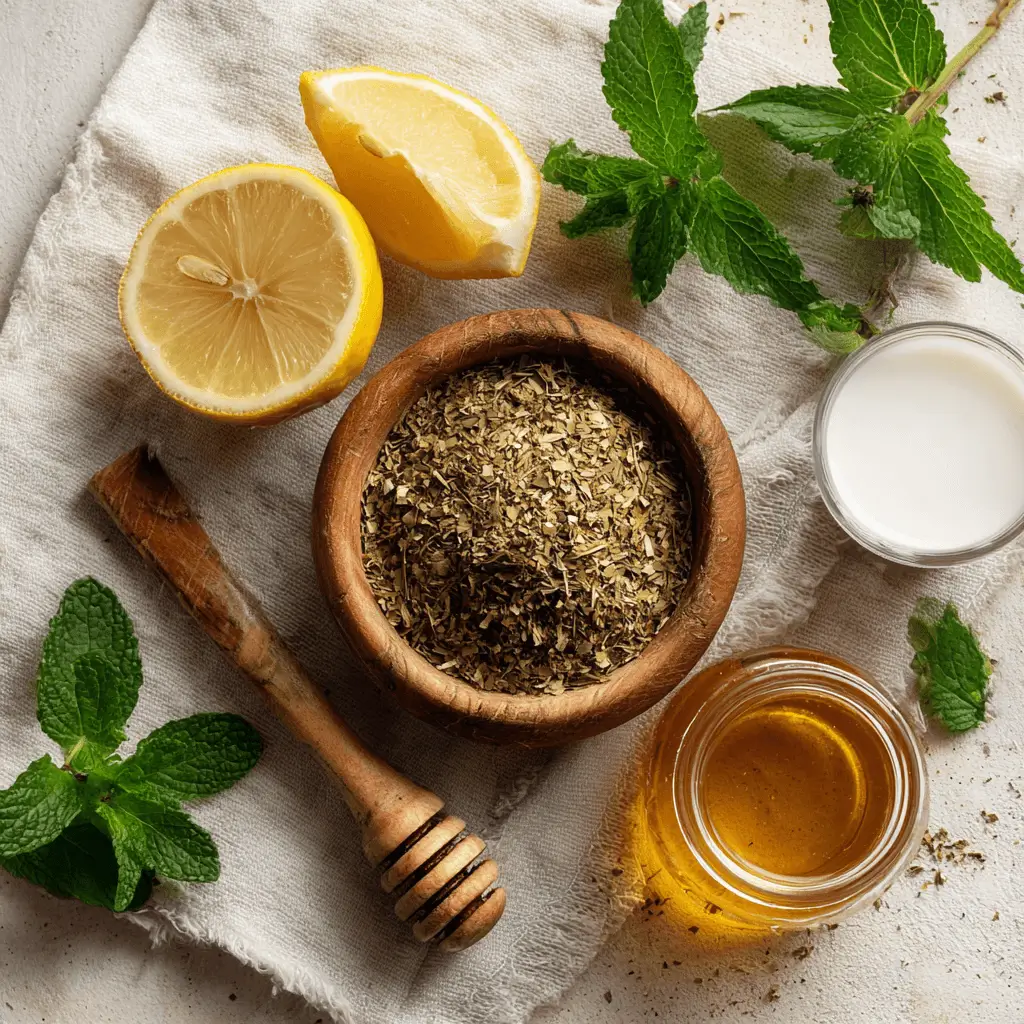
Keto drinkers can add MCT oil or coconut cream for a high-fat, energy-boosting twist. For inspiration, check out this Hot Buttered Prune Juice adaptation or even blend with protein powder for a post-workout mate shake.
How to Prepare Traditional Yerba Mate (Step-by-Step)
You don’t need to be a purist to make mate the right way just a few essentials, some patience, and a good attitude. Below is a simple guide to get you sipping like a local.
- Fill the gourd ⅔ full with yerba mate.
Tilt the gourd slightly as you pour so that the yerba settles on one side. This forms a gentle slope and leaves a hollow “well” on the other side. - Insert your bombilla before adding water.
Place the bombilla (metal straw) into the lower side of the slope, into the empty space. This stabilizes it and prevents clogging.
Crucially, do not move or stir with the bombilla once it is placed. - Moisten the yerba with cool water first (room temperature or ~100°F/38°C).
Let it absorb for about 30 seconds. This “awakens” the leaves gently and prevents them from being shocked by heat, preserving flavor and nutrition. - Pour hot water (130–160°F / 55–70°C) slowly into the well.
Never use boiling water it will scald the leaves and create a bitter taste. A thermometer helps here, or wait 10 minutes after boiling. - Sip slowly and refill as needed.
Drink the entire portion in one or two sips. Refill the same spot with hot water each time and pass it around if sharing. The first few pours are strongest. - Repeat until flavor fades.
Good yerba can be steeped 10–20 times, gradually mellowing with each round.
Cold Brew Tip: Want something refreshing? Fill a thermos with ice water, add yerba to a French press or bottle, and steep in the fridge for 6–8 hours. This cold method, called tereré, is ideal for hot weather.
Traditional yerba mate isn’t just about brewing it’s about respecting a process that’s been passed down for generations. Once you get the rhythm, it becomes second nature.
Beyond the Gourd: 5 Essential Yerba Mate Recipes
Whether you’re looking to beat the heat, boost your energy, or find a keto-friendly latte alternative, yerba mate can do it all. These five recipes are delicious, beginner-friendly, and ideal for experimenting with different flavors.
1. The Perfect Hot Brew (Traditional Style)
This is the foundational recipe. Simple, strong, and culturally authentic.
Print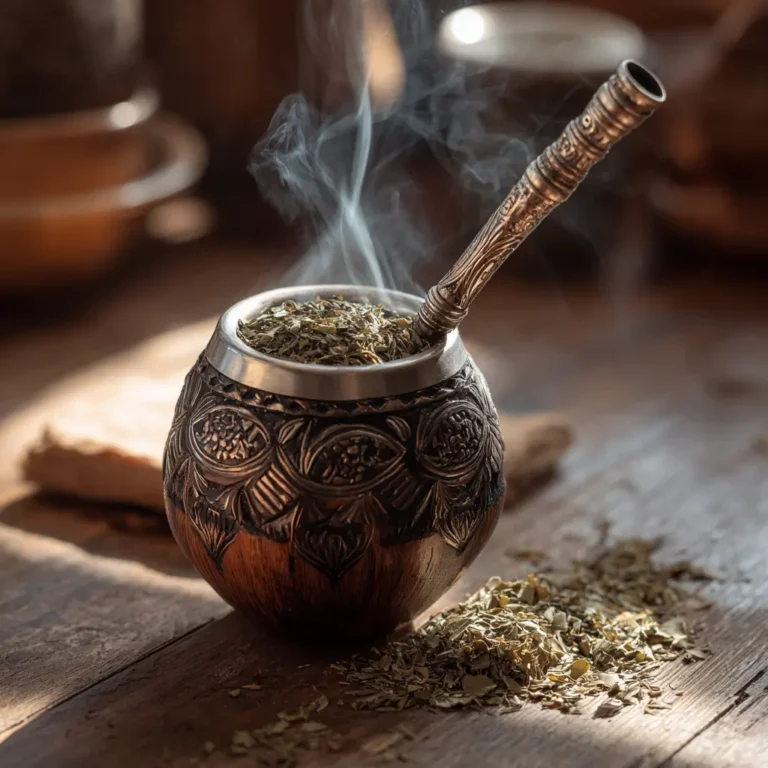
Traditional Hot Brew Yerba Mate
A traditional South American yerba mate brewed in a gourd with a bombilla. Rich, earthy, and perfect for slow sipping.
- Total Time: 7 mins
- Yield: 1 serving 1x
Ingredients
2/3 cup loose leaf yerba mate
Cool water (room temperature)
Hot water (130–160°F / 55–70°C)
Instructions
1. Fill a gourd 2/3 full with yerba mate, forming a slight slope to one side.
2. Tilt the gourd so the yerba gathers on one side and a hollow space forms on the other.
3. Pour a little cool water into the hollow and let it absorb (about 30 seconds).
4. Insert the bombilla into the hollow—do not stir.
5. Slowly add hot water into the same spot. Sip and refill as needed. Leaves can be reused 10–20 times.
Notes
Do not use boiling water it burns the leaves and alters the flavor.
Never stir with the bombilla it causes clogging.
Use a thermometer if needed to keep water between 130–160°F.
- Prep Time: 2 mins
- Cook Time: 5 mins
- Category: Drinks
- Method: Brewed
- Cuisine: South American
Nutrition
- Serving Size: 1 cup
- Calories: 5
- Sugar: 0g
- Sodium: 0mg
- Fat: 0g
- Saturated Fat: 0g
- Unsaturated Fat: 0g
- Trans Fat: 0g
- Carbohydrates: 1g
- Fiber: 0g
- Protein: 0g
- Cholesterol: 0mg
2. Refreshing Cold Brew Yerba Mate (Tereré Style)
This cold-brewed yerba mate is traditional in Paraguay and ideal for hot days.
Print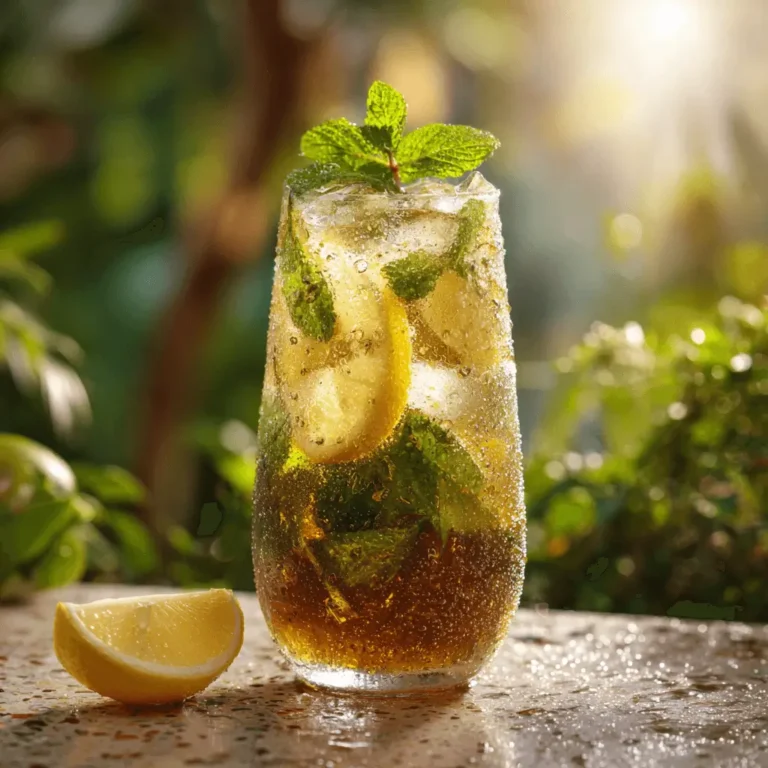
Refreshing Cold Brew Yerba Mate (Tereré Style)
A cool and refreshing way to enjoy yerba mate, tereré is a traditional cold brew from Paraguay that hydrates and energizes perfect for hot weather or workout recovery.
- Total Time: 20 mins
- Yield: 2 servings 1x
Ingredients
1/2 cup yerba mate (preferably Paraguayan or unsmoked)
16 oz cold filtered water
1 lemon or lime slice (optional)
Fresh mint leaves (optional)
Ice cubes
Instructions
1. Add yerba mate to a French press, glass jar, or thermos.
2. Pour cold filtered water over the yerba mate.
3. Let steep for at least 20 minutes, or up to 12 hours in the fridge for stronger flavor.
4. Strain using a French press or fine mesh sieve.
5. Serve over ice with lemon or mint if desired.
Notes
Use air-dried, unsmoked yerba mate (sin humo) for a smoother taste.
Paraguayan yerba mate is ideal for tereré due to its fine cut and bold flavor.
Try infusing with cucumber, orange slices, or berries for a fruity twist.
- Prep Time: 5 mins
- Cook Time: 0 mins
- Category: Cold Drinks
- Method: Cold Brew
- Cuisine: Paraguayan
Nutrition
- Serving Size: 1 cup
- Calories: 2
- Sugar: 0g
- Sodium: 0mg
- Fat: 0g
- Saturated Fat: 0g
- Unsaturated Fat: 0g
- Trans Fat: 0g
- Carbohydrates: 1g
- Fiber: 0g
- Protein: 0g
- Cholesterol: 0mg
Pair with: Light snacks or our Vegan Fruit Dip for a clean energy combo.
3. Fruity Iced Yerba Mate
Bright and citrusy, this one’s a summer crowd-pleaser.
Print
Fruity Iced Yerba Mate
This fruity iced yerba mate is a vibrant twist on the classic cold brew, infused with citrus, berries, and a splash of natural sweetness. It’s energizing, hydrating, and perfect for summer.
- Total Time: 4 hrs
- Yield: 2 servings 1x
Ingredients
1/2 cup yerba mate (unsmoked or lightly smoked)
16 oz cold filtered water
1/2 orange, sliced
1/2 lemon, sliced
4 strawberries, halved
1 tsp honey or agave (optional)
Fresh mint (optional)
Ice cubes
Instructions
1. Add yerba mate and cold water to a large jar or pitcher.
2. Add orange slices, lemon slices, and strawberries.
3. Optional: Stir in honey or agave for a hint of sweetness.
4. Let steep in the fridge for 4–12 hours.
5. Strain and serve over ice with fresh mint.
Notes
For stronger flavor, steep overnight.
Try substituting strawberries with raspberries or pineapple for a tropical twist.
To make it sparkling, top with soda water just before serving.
- Prep Time: 10 mins
- Cook Time: 0 mins
- Category: Cold Drinks
- Method: Infusion
- Cuisine: Fusion
Nutrition
- Serving Size: 1 glass
- Calories: 15
- Sugar: 3g
- Sodium: 0mg
- Fat: 0g
- Saturated Fat: 0g
- Unsaturated Fat: 0g
- Trans Fat: 0g
- Carbohydrates: 4g
- Fiber: 0g
- Protein: 0g
- Cholesterol: 0mg
Bonus: Add a splash of soda water for a yerba spritz!
4. Creamy Yerba Mate Latte
Smooth and energizing this is your go-to yerba mate latte.
Print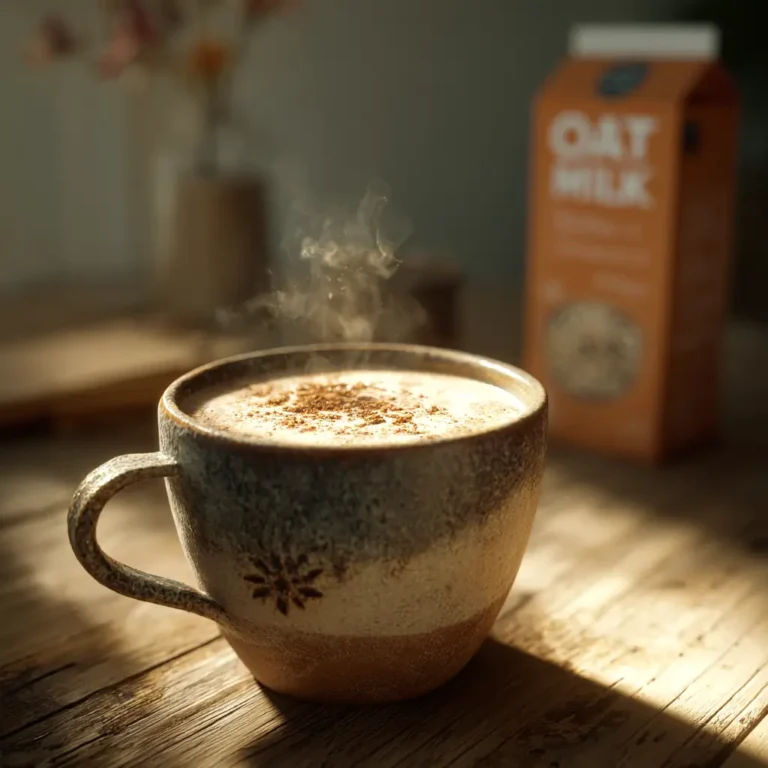
Creamy Yerba Mate Latte
This creamy yerba mate latte is your new favorite morning ritual warm, comforting, and softly energizing with a subtle herbal kick and a creamy finish.
- Total Time: 10 mins
- Yield: 1 serving 1x
Ingredients
1 tbsp loose leaf yerba mate (preferably unsmoked)
8 oz filtered water (150°F or 65°C)
1/2 cup unsweetened oat milk or almond milk
1 tsp honey or maple syrup (optional)
Pinch of cinnamon (optional)
Instructions
1. Steep yerba mate in hot water (150°F) for 5 minutes using a French press or tea infuser.
2. Warm the oat or almond milk in a small saucepan or frother.
3. Optional: Froth the milk for a foamier latte texture.
4. Combine the strained mate infusion with warm milk.
5. Stir in sweetener and sprinkle with cinnamon if using.
Notes
For a richer version, use barista-style oat milk.
Add vanilla extract or a dash of cardamom for variation.
This latte has less caffeine than coffee but offers a smoother energy boost.
- Prep Time: 5 mins
- Cook Time: 5 mins
- Category: Hot Beverages
- Method: Steep and Froth
- Cuisine: Wellness Fusion
Nutrition
- Serving Size: 1 cup
- Calories: 45
- Sugar: 4g
- Sodium: 20mg
- Fat: 1g
- Saturated Fat: 0g
- Unsaturated Fat: 0.5g
- Trans Fat: 0g
- Carbohydrates: 8g
- Fiber: 0g
- Protein: 1g
- Cholesterol: 0mg
Make it indulgent: Sprinkle cinnamon on top for cozy vibes.
5. Keto Coconut Yerba Mate Latte
High in healthy fats, low in carbs. Perfect for a keto yerba mate recipe.
Print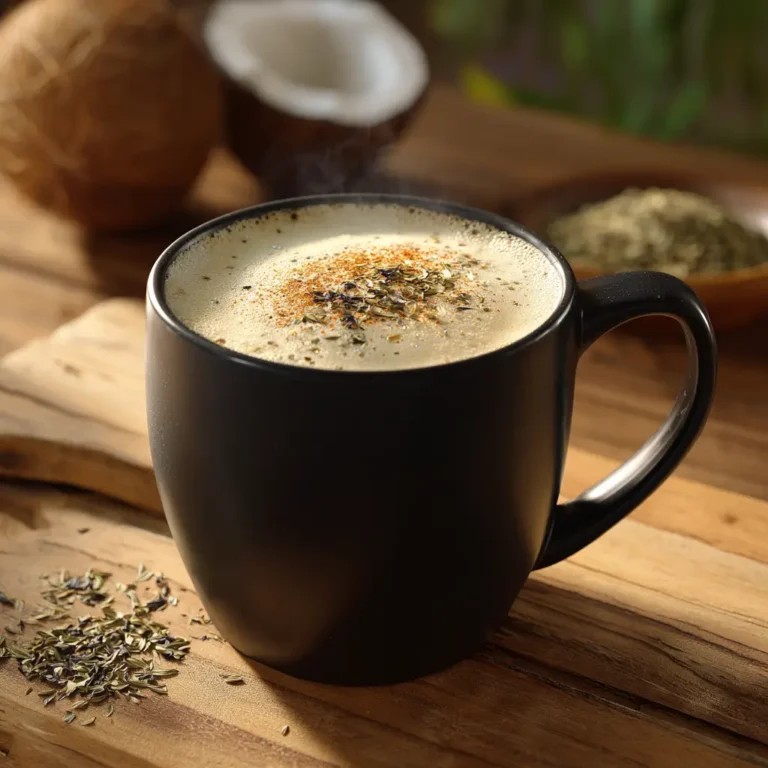
Keto Coconut Yerba Mate Latte
This keto-friendly yerba mate latte uses creamy coconut milk and MCT oil for sustained energy, blended with unsmoked yerba mate for a nourishing, energizing sip that’s sugar-free and satisfying.
- Total Time: 10 mins
- Yield: 1 serving 1x
Ingredients
1 tbsp loose leaf yerba mate (unsmoked preferred)
8 oz hot water (150°F/65°C)
1/2 cup canned coconut milk (full-fat)
1 tsp MCT oil or coconut oil
Few drops liquid stevia or monk fruit (optional)
Dash of cinnamon or vanilla (optional)
Instructions
1. Steep yerba mate in hot water (150°F) for 5 minutes using a French press or infuser.
2. Warm coconut milk in a small saucepan or frother.
3. Blend strained yerba mate with warm coconut milk and MCT oil.
4. Add sweetener, cinnamon, or vanilla if desired.
5. Blend or whisk until creamy. Serve immediately.
Notes
Use a handheld frother or blender for best consistency.
MCT oil boosts energy and fat-burning on keto.
Unsmoked mate keeps the flavor mild and avoids PAHs.
- Prep Time: 5 mins
- Cook Time: 5 mins
- Category: Hot Keto Beverages
- Method: Infuse and Blend
- Cuisine: Keto Wellness
Nutrition
- Serving Size: 1 mug
- Calories: 110
- Sugar: 0g
- Sodium: 10mg
- Fat: 11g
- Saturated Fat: 9g
- Unsaturated Fat: 1g
- Trans Fat: 0g
- Carbohydrates: 1g
- Fiber: 0g
- Protein: 0g
- Cholesterol: 0mg
Looking for more low-carb options? You might enjoy our Keto Chicken Empanadas or Blue Tonic Weight Loss Drink too.
Conclusion
Yerba mate isn’t just a drink it’s a lifestyle that balances energy, ritual, and wellness in every sip. Whether you’re drawn to the earthy simplicity of Argentinian mate, the bold complexity of Paraguayan tereré, or the creamy depth of a latte blend, there’s a version to suit your rhythm.
From its deep cultural roots in South America to its modern wellness adaptations, yerba mate offers a unique combination of sustained energy, rich antioxidants, and mindful ritual. By selecting the right type for your palate, brewing at a safe temperature, and choosing unsmoked varieties, you can enjoy its benefits while minimizing potential risks. Whether you steep it in a traditional gourd or brew it in a French press, this plant has a place in any health-focused lifestyle.
This guide has given you the tools to confidently take your first sip and maybe your hundredth with purpose and tradition. Welcome to the world of yerba mate.
Love simple, healthy recipes like this?
Follow me on Pinterest and Facebook for fresh, easy meals straight from my kitchen to yours.
Yerba Mate FAQ
How to make your own yerba mate?
To brew traditional yerba mate, fill a gourd ⅔ full with loose leaves. Tilt to one side, insert a bombilla, add a splash of cool water, then pour hot (not boiling) water slowly and sip. Repeat with refills. For a beginner-friendly method, use a French press and steep for 5–7 minutes. Try sweeteners, citrus, or herbs for flavor twists.
Is yerba mate ok to drink daily?
Yes, many people drink yerba mate daily without issues. One to three servings per day is generally considered safe for most healthy adults. However, if you’re sensitive to caffeine or prone to insomnia or anxiety, start slow and observe how your body reacts.
What do you mix with yerba mate?
Yerba mate pairs beautifully with lemon, orange, mint, ginger, or hibiscus. You can also mix it with milk (for a latte), coconut cream (for keto recipes), or sweeteners like honey or agave. For cold infusions, berries and cucumber are great add-ins.
What’s the best way to drink yerba mate?
It depends on your taste and tools. Traditional gourds offer the authentic experience. A French press is convenient for beginners. Cold-brew is great for hydration and warm weather, while lattes and fruity iced mates suit modern palates.
When not to drink yerba mate?
Avoid yerba mate if you are pregnant, nursing, or have a history of caffeine sensitivity, heart issues, or anxiety. Don’t drink it at night if you’re sensitive to stimulants. Also, avoid consuming it extremely hot (above 149°F) to reduce cancer risk associated with very hot beverages.
